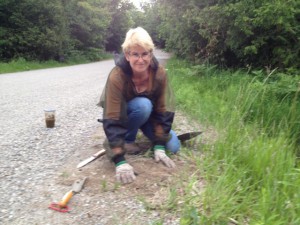The weather is warm, overcast, and humid – conditions that female snapping turtles in our region apparently consider ideal to unload their burden of eggs on the gravel shoulders of rural roads.
Yesterday afternoon HNPNC President Fiona Reid spotted several egg-laying turtles during one short drive:
On my way home from dropping my son at school yesterday I found three snapping turtles laying eggs along the side of the road. One was at a fast and quite busy intersection. A worker from Halton Hills Hydro was about to pick her up and move her with a shovel but I asked him to leave her as she had not finished laying eggs. Very grumpily he agreed, saying it would be my fault if she got hit. Well, the best pond was right behind her and I thought she might well turn around. I went home, grabbed supplies (signs, boards, tape etc) and headed back. I found another three turtles, 6 total. One was not laying (may have already done so). They were spread over about 2 km, so I drove back and forth checking on each one. They all faced the road when laying, but each one turned and went back away from the road, although one walked a long way along the bank before going into the forest. Now they are all safely in the ponds and woods!
My conclusion is that it is better not to move an egg-laying turtle but to see where she heads after she is done.

Females don’t start breeding until they are 15-20 years old, so it’s no wonder the Snapping Turtle is listed as a special concern species both provincially and nationally.
Knowing that very few eggs survive intact to hatching, Fiona and I returned to the nest sites last evening to see what we could do to protect the eggs from scavengers.
We covered 5 nests with chicken wire and anchored them with rocks and dirt. Fiona has read that racoons hate mint, so we applied a liquid mixture of mint mixed with chili powder to two of the nests, and sprayed two more nests with Bitter Apple (a commercial products used to deter puppies from chewing). We sprayed both repellents on the fifth nest. We found four more nests and sprayed two of them but did not cover them with chicken wire; we left the last two completely unprotected as controls for our little study.
Fiona will continue to monitor the nests to see if our efforts pay off. Incubation time is heavily dependent on temperature, and in Halton Hills we are near the northern limit of their range so it may be another 90-120 days before the hatchlings emerge.



